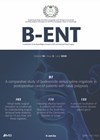
Journal Reviews archive for January 2021
Smartphone hearing test
Our Editors’ Choice for this edition reviews an article looking at the use of a smartphone app for hearing screening. We have all had to integrate telehealth into our practice to some extent recently and this paper examines a teleaudiology...
Stepwise approach to manage palatal myoclonus successfully
Palatal myoclonic tinnitus (PMT) is a rare condition caused by rhythmic voluntary or involuntary movements of the soft palate, mainly the tensor veli palatini and levator veli palatine muscles. Patients usually present with a ‘clicky’ noise in the ear. Oral...
Persistent symptoms of smell loss after COVID-19 infection
Anosmia as a result of COVID-19 infection is well recognised. This timely and topical French paper looks at 115 patients with proven SARS-CoV-2 infection, who were contacted with specific questions about olfactory and gustatory disturbance. They found 81% of patients...
Otosclerosis - to scan or not to scan?
In an era of insidiously reducing thresholds for investigating patients, Maxwell and colleagues pose an important question: is high-resolution computed tomography (HRCT) prior to stapes surgery for otosclerosis worthwhile? Their practice typically considers HRCT for cases of suspected otosclerosis presenting...
Satisfaction levels in elderly patients with cochlear implants
Hearing rehabilitation in the elderly is of utmost importance as it is associated with depression and dementia in this age group. Cochlear implantation is indicated for hearing-impaired individuals who do not derive adequate benefit from conventional hearing aids. In this...
PET-CT for malignant nasopharyngeal lesions
This retrospective Turkish review of 92 patients aimed to determine the ability of fluorine 18-fluorodeoxyglucose (FDG) maximum standardised uptake value (SUVmax) on positron emission tomography/computerised tomography (PET/CT) to differentiate benign processes and malignant nasopharyngeal lesions. The authors retrospectively reviewed the...
Predicting swallowing outcomes post radiotherapy for head and neck cancer
A videofluroscopic swallow study (VFSS), also known as modified barium swallow (MBS) offers a dynamic view of swallow biomechanics and associated swallowing physiology. The authors of this paper investigated whether quantitative timing and displacement measures of key structures involved in...
Neuromodulation in drug resistant epilepsy
Treatment of epilepsy can be considered generally as medical or surgical. Anti-epileptic drugs achieve a five-year seizure freedom in 54-70% patients. It is estimated that 50-90% of patients with drug-refractory epilepsy may not be candidates for resective surgery. For example,...
CI outcome measures and different languages
Outcome measures for hearing rehabilitation strategies in children are the subject of endless debate. The underlying problem with measuring outcomes in this population is delineating the extent to which development (which is in itself variable) and hearing ability (usually the...
Swallowing it whole: the physical and psychological consequences of dysphagia
Living with dysphagia in the real world can be extremely challenging, both practically and psychologically. Long-term changes in taste due to chemo-radiation treatment for head and neck cancer, fatigue due to Parkinson’s disease, and physically impaired structures due to stroke...
Chronic phase of concussion and stability of gaze
It has been known that vestibular symptoms can persist for several months after concussion. The authors designed this study to assess the effect of chronic concussion (more than one year) on gaze stability and the relationship between deficits in gaze...
Is flexible nasendoscopy really aerosol generating?
Amid the COVID-19 pandemic, the safety of office-based laryngoscopy has been a source of considerable concern, speculation and debate. Flexible nasendoscopy is a key diagnostic tool in the assessment of the ENT patient, however most healthcare providers consider this to...

















